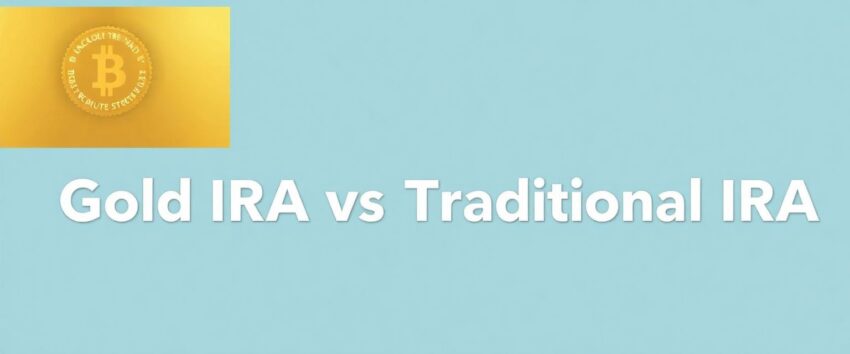This post contains affiliate links. Click Here to read my affiliate disclaimer.
When planning for retirement, choosing the right investment vehicle is a critical decision. Traditional Individual Retirement Accounts (IRAs) have long been a go-to option for retirement savings, but in recent years, Gold IRAs have gained popularity as a means to diversify portfolios and protect against economic uncertainty.
This detailed guide will compare Gold IRAs and Traditional IRAs, breaking down their key features, advantages, and drawbacks, so you can determine which option aligns best with your financial goals.
What is a Traditional IRA?
A Traditional IRA is a tax-advantaged retirement account that allows individuals to save for retirement while deferring taxes on their contributions and earnings. Contributions are typically tax-deductible, and earnings grow tax-deferred until withdrawals are made during retirement.
Key Features of a Traditional IRA
- Tax Benefits: Contributions may be tax-deductible, reducing your taxable income for the year.
- Wide Range of Investments: Includes stocks, bonds, mutual funds, and ETFs.
- Required Minimum Distributions (RMDs): Withdrawals must begin at age 73 (as of 2023).
- Contribution Limits: \$6,500 annually (\$7,500 for those aged 50 and above).
What is a Gold IRA?
A Gold IRA is a self-directed IRA that allows investors to hold physical gold, silver, platinum, and palladium within a tax-advantaged retirement account. Unlike Traditional IRAs, which focus on paper assets, Gold IRAs provide the opportunity to invest in tangible, precious metals.
Key Features of a Gold IRA
- Physical Assets: Includes IRS-approved gold bars and coins.
- Self-Directed: Offers more control over investment choices.
- Secure Storage: Requires assets to be stored in an IRS-approved depository.
- Hedging Benefits: Protects against inflation and market volatility.
Comparing Gold IRAs and Traditional IRAs
1. Investment Options
- Traditional IRA: Offers a diverse range of paper assets like stocks, bonds, and mutual funds, providing potential for high growth but higher risk during market downturns.
- Gold IRA: Limited to physical precious metals, offering stability and a hedge against inflation but with no potential for dividends or interest.
2. Tax Benefits
- Traditional IRA: Contributions are tax-deductible (subject to income limits), and earnings grow tax-deferred. Withdrawals during retirement are taxed as ordinary income.
- Gold IRA: Offers similar tax advantages, with contributions potentially deductible and tax-deferred growth. Withdrawals are taxed as income.
3. Risk and Volatility
- Traditional IRA: Highly influenced by stock market fluctuations, making it more susceptible to economic downturns.
- Gold IRA: Provides a stable asset that often moves inversely to the market, serving as a safe-haven investment during financial crises.
4. Fees and Costs
- Traditional IRA: Typically lower fees, with minimal account maintenance costs.
- Gold IRA: Involves additional fees for setup, storage, and custodian services, which can range from \$200 to \$500 annually.
5. Liquidity
- Traditional IRA: Easier to liquidate assets like stocks and bonds, allowing quick access to funds.
- Gold IRA: Selling physical gold requires coordination with your custodian and depository, which can take time.
6. Long-Term Value
- Traditional IRA: Growth potential is tied to market performance, which can be unpredictable over time.
- Gold IRA: Gold has maintained its intrinsic value over centuries, making it a reliable choice for wealth preservation.
Advantages of a Gold IRA
- Inflation Hedge: Gold preserves purchasing power as fiat currencies depreciate.
- Portfolio Diversification: Reduces reliance on paper assets and balances risk.
- Tangible Asset Ownership: Offers security that paper investments cannot.
- Safe-Haven Asset: Gold’s value often rises during economic crises, providing stability.
Advantages of a Traditional IRA
- Tax Deductibility: Contributions lower taxable income in the year they’re made.
- High Growth Potential: Exposure to stocks and mutual funds offers opportunities for substantial growth.
- Simplicity: Traditional IRAs are easier to set up and manage compared to Gold IRAs.
- Low Costs: Lower fees make it more affordable for many investors.
Drawbacks of a Gold IRA
- Higher Fees: Costs for account setup, storage, and insurance can add up.
- Limited Growth Potential: Relies solely on the price appreciation of gold, with no dividends or interest.
- Complex Regulations: IRS rules on eligible metals and storage are stringent.
Drawbacks of a Traditional IRA
- Market Volatility: Highly dependent on the stock market’s performance.
- Inflation Risk: Paper assets lose value as inflation rises.
- RMDs: Mandatory withdrawals can disrupt financial planning.
Factors to Consider When Choosing Between a Gold IRA and a Traditional IRA
1. Your Financial Goals
- Are you looking for high growth potential? A Traditional IRA may be more suitable.
- Do you value stability and long-term preservation? A Gold IRA could be the better choice.
2. Risk Tolerance
- If you’re comfortable with market fluctuations, a Traditional IRA offers opportunities for higher returns.
- For risk-averse investors, the stability of a Gold IRA is appealing.
3. Diversification Needs
- Combining both a Traditional and Gold IRA can create a well-balanced portfolio, leveraging the benefits of paper and physical assets.
4. Costs
- Assess whether you can afford the higher fees associated with Gold IRAs while still meeting your retirement savings goals.
Can You Combine a Gold IRA and a Traditional IRA?
Yes, you can hold both types of IRAs to create a diversified retirement strategy that leverages the unique benefits of each account type. By combining a Gold IRA and a Traditional IRA, you can mitigate risks while maximizing growth potential. Many financial advisors recommend allocating 5-10% of your portfolio to precious metals to protect against inflation and market volatility while dedicating the remainder to traditional investments like stocks and bonds for higher growth potential.
This approach ensures a well-rounded portfolio, balancing the stability and security of gold with the growth opportunities offered by equities and mutual funds. Additionally, working with reputable providers like Augusta Precious Metals and Goldco can help streamline the process of managing multiple IRAs. These companies provide expert guidance, ensuring that your portfolio aligns with your retirement goals and remains compliant with IRS regulations.
Steps to Open a Gold IRA
- Choose a Reputable Custodian: Selecting the right custodian is the foundation of your Gold IRA journey. Look for an IRS-approved custodian with extensive experience managing precious metals IRAs. Two highly-rated providers are:
- Augusta Precious Metals: Known for their exceptional customer service and transparent fee structures, Augusta focuses on educating investors about Gold IRAs through one-on-one consultations and comprehensive resources.
- Goldco: Ideal for first-time investors, Goldco offers a wide range of gold and silver products along with strong customer support and competitive pricing.
- Fund the Account: You can fund your Gold IRA through multiple methods:
- Direct Contributions: Add funds within annual IRS contribution limits ($6,500 for 2025; $7,500 for those aged 50 or older).
- Rollover: Transfer funds from an existing IRA or 401(k) into your new Gold IRA. Ensure the transfer complies with IRS rules to avoid penalties.
- Custodian-to-Custodian Transfer: This seamless option involves moving funds directly from one custodian to another without incurring taxes or penalties.
- Select Approved Metals: Work with your custodian or dealer to purchase IRS-approved precious metals. Popular options include:
- American Gold Eagles: A reliable and highly liquid choice.
- Canadian Gold Maple Leafs: Renowned for their purity and global recognition.
- PAMP Suisse Gold Bars: Premium-quality gold bars with excellent market reputation.
- Arrange for Secure Storage: The IRS mandates that all Gold IRA assets must be stored in an approved depository. Reputable custodians like Augusta and Goldco partner with trusted depositories, offering:
- Segregated Storage: Ensures your metals are stored separately from other investors’ assets.
- Non-Segregated Storage: A cost-effective option where assets are stored collectively but still insured and secure.
FAQs About Gold IRAs and Traditional IRAs
1. Can I convert a Traditional IRA into a Gold IRA?
Yes, you can roll over funds from a Traditional IRA into a Gold IRA without incurring taxes or penalties, provided IRS rules are followed.
2. Are Gold IRAs safe?
Gold IRAs are considered safe due to the intrinsic value of gold, but they still carry risks, such as price volatility and storage costs.
3. Which IRA offers better tax advantages?
Both offer significant tax advantages, but the right choice depends on your financial situation and retirement goals.
4. How much of my portfolio should be in gold?
Financial experts typically recommend allocating 5-10% of your portfolio to gold to maintain balance and diversification.
Conclusion: Which IRA is Right for You?
Both Gold IRAs and Traditional IRAs have unique advantages and drawbacks, making them suitable for different types of investors. If you prioritize growth and are comfortable with market fluctuations, a Traditional IRA might be your best bet. However, if stability, diversification, and protection against economic uncertainty are your goals, a Gold IRA could be the ideal addition to your retirement strategy.
Ready to explore your options? Contact a trusted Gold IRA provider today to secure your financial future with the stability and reliability of gold. By understanding the key differences between these accounts, you can make an informed decision that supports your retirement goals.

